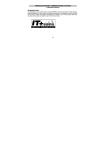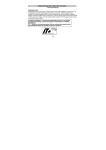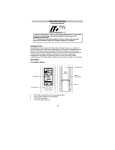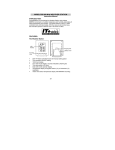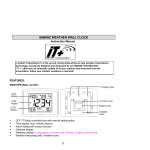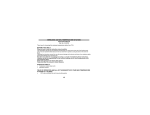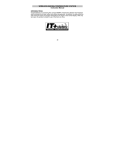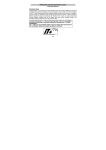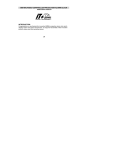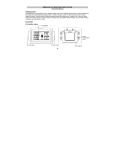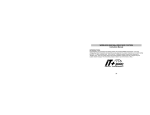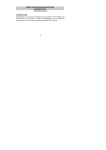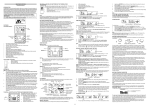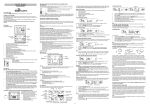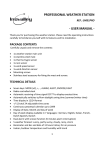Download WIRELESS 433 MHz TEMPERATURE STATION
Transcript
WIRELESS 433 MHz TEMPERATURE STATION Instruction Manual INTRODUCTION: Congratulations on purchasing this Temperature Station with wireless 433 MHz Weather Station which displays the time, date, indoor temperature, and up to three outdoor temperature readings. It is further featuring a DCF-77 radio controlled clock with calendar display and two alarms. With eight easy to use function keys, this innovative product is ideal for use in the home or office. FEATURES: The Temperature Station Hanging Hole LCD Display Battery cover Function keys Detachable stand 25 • • • • • • • • • • • • DCF-77 Radio controlled time with manual setting option 24 hour display Time zone option ±9 hours Hour and minute display, seconds indicated by flashing dot Features 2 alarms with snooze function Weekday with date or date with month calendar display Indoor temperature reading in °C with minimum and maximum recording Outdoor temperature reading (for up to 3 transmitters) in °C with minimum and maximum recording All minimum and maximum recordings show date and time received and can be reset Can take up to three outdoor transmitters Low Battery Indicator Wall mountable or table standing The Outdoor Temperature Transmitter • Holder • 26 Remote transmission of outdoor temperature by 433 MHz signals Wall mounting case SETTING UP: 1. First, insert the batteries into the Temperature Station (see “How to install and replace batteries in the Temperature Station” below). Once the batteries are in place, all segments of the LCD will light up briefly and a short signal tone will sound. Then the indoor temperature, the time as 0:00 and the date as 1.1. will be displayed. If the indoor temperature is not displayed after a few seconds, remove the batteries and wait for at least 10 seconds before reinserting them. Once the indoor data is displayed proceed to step 2. 2. Within 3 minutes of activating the Temperature Station, place the batteries into the Temperature Transmitter (see “How to install and replace batteries in the Temperature Transmitter” below). 3. After inserting the batteries into the transmitter, the Temperature Station will start receiving transmissions from the transmitter. The outdoor temperature should then be displayed on the Temperature Station. If this does not happen within 15 minutes, the batteries will need to be removed from both units and reset from step 1. 4. The Temperature Station can take up to 3 remote transmitters. If you have purchased additional transmitters, follow step 2 for all extra transmitters. However, ensure that you leave 10 seconds in between the reception of the last transmitter and the set-up of the following transmitter. The Temperature Station will number the transmitters in the order of set-up, i.e. the first transmitter will have the temperature displayed with the number 1 against it and so on. 5. When all the transmitters are set up, there is a testing period, during which the display switches quickly between all the received transmitters at random, according to which random transmission it receives. 27 6. Pressing any key will stop this process and the display will show the temperature for the first transmitter. The process also stops automatically if no keys are pressed for a few minutes. 7. Once the remote temperature has been received and is displayed on the Temperature Station, the DCF77 time code reception is automatically started. This takes typically between 3-5 minutes in good conditions. This time period is an excellent opportunity to locate the transmitter(s) in suitable location(s) outdoors. In order to ensure sufficient 433 MHz transmission however, this should under good conditions be no more than 25 meters from where the Temperature Station will be finally positioned (see notes on “Positioning” and “433 MHz Reception check”). 8. If after 10 minutes the DCF time has not been received, use the SET key to manually enter a time initially. The clock will automatically attempt each hour to receive the DCF time. When this is successful, the received time will override the manually set time. The date is also updated with the received time (Please refer also to notes on “Radio controlled time” and “Manual time setting”). HOW TO INSTALL AND REPLACE BATTERIES IN THE TEMPERATURE STATION The Temperature Station uses 2 x AA, IEC LR6, 1.5V batteries. When batteries need to be replaced, the battery symbol will appear on the LCD. To install and replace the batteries, please follow the steps below: 1. Insert finger or other solid object in the space at the bottom center of the battery compartment and lift up to remove the cover. 2. Insert batteries observing the correct polarity (see marking). 3. Replace compartment cover. 28 HOW TO INSTALL AND REPLACE BATTERIES IN THE TEMPERATURE TRANSMITTER The transmitter uses 2 x AAA, IEC LR3, 1.5V batteries. To install and replace the batteries, please follow the steps below: 1. 2. 3. Remove the cover. Insert the batteries, observing the correct polarity (see marking). Replace the battery cover on the unit. Note: In the event of changing batteries in any of the units, all units need to be reset by following the setting up procedures. This is because a random security code is assigned by the transmitter at start-up and this code must be received and stored by the Temperature station in the first 3 minutes of power being supplied to it. BATTERY CHANGE: It is recommended to replace the batteries in all units on an annual basis to ensure optimum accuracy of these units. Please participate in the preservation of the environment. Return used batteries to an authorized depot. 29 FUNCTION KEYS: Temperature Station: The temperature station has eight easy to use function keys. Outdoor Indoor Setting Channel Alarm 1 Snooze Alarm 2 Date SET key (Setting) • Used to enter the set mode for the following functions: Time, Time zone, Year, Date and Weekday • Stop the alarm IN key (Indoor) • Toggle between the current / maximum/ minimum indoor temperature • Press for over 2 seconds to reset the indoor maximum and minimum temperature records (will reset all temperatures to current level) • Change the hour, time zone, year, day and weekday setting when in set mode • Change the hour setting in alarm mode • Stop the alarm OUT key (Outdoor) • Toggle between the current / maximum/ minimum outdoor temperatures 30 • • • • Press for around 2 seconds to reset the outdoor maximum and minimum temperature records (will reset all temperatures to current level of the relative transmitter being reset- each transmitter’s data must be reset separately) Changes\ the minute and month setting when in set mode Change the minute setting in alarm setting mode Stop the alarm CH key (Channel) • Used to toggle between the outdoor temperature transmitters 1, 2 and 3. • Stop the alarm • Exit any set mode AL1 key (Alarm 1) • Press to display the time set for Alarm ((1)) and to simultaneously set Alarm ((1)) ON/ OFF • Press for around 2 seconds to enter the Alarm ((1)) setting mode • Stop the alarm AL2 key (Alarm 2) • Press to display the time set for Alarm ((2)) and to simultaneously set Alarm ((2)) ON/ OFF • Press for around 2 seconds to enter the Alarm ((2)) setting mode • Stop the alarm 31 DATE key • Toggle between the two date display modes and the two alarm times • Stop the alarm SNZ key (Snooze) • Activate the snooze function for the alarm LCD SCREEN AND SETTINGS DCF reception icon Time Alarm 1 icon Calendar Indoor temperature in ºC Outdoor temperature in ºC Outdoor transmitter identification number 32 2 Outdoor reception icon For better distinctness the LCD screen is split into 4 sections displaying the information for time, date, indoors and outdoors. LCD 1 RADIO CONTROLLED TIME: Minutes (flashing) Hour (flashing) The time base for the radio-controlled time is a Cesium Atomic Clock operated by the Physikalisch Technische Bundesanstalt Braunschweig which has a time deviation of less than one second in one million years. The time is coded and transmitted from Mainflingen near Frankfurt via frequency signal DCF-77 (77.5 kHz) and has a transmitting range of approximately 1,500 km. Your radio-controlled Temperature Station receives this signal and converts it to show the precise time in summer or wintertime. The quality of the reception depends greatly on the geographic location. In normal cases, there should be no reception problems within a 1500km radius of Frankfurt. Once the outdoor temperature is displayed on the Temperature Station, the DCF tower icon in the clock display will start flashing in the upper left corner. This indicates that the clock has detected that there is a radio signal present and is trying to receive it. When the time code is received, the DCF tower becomes permanently lit and the time will be displayed. If the tower icon flashes, but does not set the time or the DCF tower does not appear at all, then please take note of the following: 33 • • • Recommended distance to any interfering sources like computer monitors or TV sets is a minimum of 1.5 - 2 meters. Within ferro-concrete rooms (basements, superstructures), the received signal is naturally weakened. In extreme cases, please place the unit close to a window and/ or point its front or back towards the Frankfurt transmitter. During nighttime, the atmospheric disturbances are usually less severe - the reception is possible in most cases. A single daily reception is adequate to keep the accuracy deviation below 1 second. MANUAL TIME SETTING: In case the Temperature Station is not able to detect the DCF-signal (disturbances, transmitting distance, etc.), the time can be manually set. The clock will then work as a normal Quartz clock: 1. Press and hold down the SET key for around 2 seconds until the time display flashes. 2. Use the IN key to set the hours and the OUT key to set the minutes. Pressing these keys continuously moves the hours consecutively by 1 and the minutes consecutively by 5. 3. Either press the SET key once more to enter the set mode for the time zone and date section or do not touch any buttons for around 30 seconds to confirm the set time. Note: The unit will still try to receive the signal every hour despite it being manually set. When it does receive the signal, it will change the manually set time into the received time. During reception attempts the DCF tower 34 icon will flash. If reception has been unsuccessful, then the DCF tower icon will not appear but reception will still be attempted the following hour. TIME ZONE SETTING: Time Zone (flashing) The time zone default of the Weather Station is 0. To reset the time zone: 1. The current time zone value starts flashing. 2. Use the IN key to set the time zone. The range runs from 9 to -9 and then runs from -9 back to 0 in consecutive 1-hour interval. 3. Press the SET key to enter the Date setting mode or do not touch any buttons for 30 seconds to confirm the time zone setting. LCD 2 DATE SETTING: The second section of the LCD shows the weekday and date, Alarm ((1)) time or Alarm ((2)) time. It also shows the Alarm ON/OFF icons ((1)) and ((2)). 35 DATE SETTING : Year (flashing) Date (flashing) Month (flashing) Weekday (flashing) Date (flashing) The date default of the Temperature Station is 1.1. or WE 1. in the year 2003. Once the radio-controlled time signals are received, the date is automatically updated. If the signals are not received, you can adjust the date manually. To do this: 1. Press the SET key after completing the time zone setting in order to enter the year setting (flashing). Reset the year by pressing the IN key. The range runs from 2000 to 2029. 2. Press the SET key again to enter the month and date display (flashing). 3. Using the OUT key, set the month required. Using the IN key, set the date required. 4. Press the SET key again to enter the weekday display (flashing). 5. Using the IN key, set the weekday required. 6. Press the SET key once more to confirm all settings or do not touch any buttons for around 30 seconds. The mode will return to normal. ALARM SETTING: 1. Press and hold down the AL1 key for around 2 seconds until the alarm time display flashes. 36 2. 3. 4. 5. 6. Use the IN key to set the hour and the OUT key to set the minutes. Pressing these keys continuously moves the hours consecutively by 1 and the minutes consecutively by 5. Either press the AL1 key once more to confirm and return to the normal display or do not touch any buttons for around 30 seconds to confirm the set time. To activate the alarm function, press the AL1 button once for Alarm 1. You should now see the Alarm ((1)) symbol to represent the Alarm 1 being ON. To de-activate, press the AL1 button once again. The steps for setting, activating and de-activating Alarm 2 are the same, but using the AL2 button instead of AL1. SNOOZE SETTING AND STOPPING THE ALARM: 1. 2. When the alarm is sounding, press the SNZ to activate the snooze function. The alarm will stop and re-activate after the snooze interval of 9 minutes. To stop the alarm completely, press any one of the seven keys SET, IN, OUT, AL1, AL2, DATE or CH. LCD 3 INDOOR TEMPERATURE: Indoor Temperature in °C 37 The indoor temperature is received automatically and displayed on the third section of the LCD. TOGGLING AND RESETTING THE INDOOR RECORDINGS: 1. 2. To toggle between the indoor current, minimum and maximum temperature data and the times at which they were recorded, press the IN key: Once to show the minimum temperature values with time and date recorded. Twice to show the maximum temperature values with time and date recorded. Three times to return to the current time, date and temperature levels. To reset the minimum and maximum temperature data and the times at which they were recorded, press the IN key continuously for about 2 seconds. This will reset all minimum and maximum data recorded to the current time, date and temperature. The min/max temperatures recorded are of current time and they remain unaffected by the time zone setting. LCD 4 OUTDOOR TEMPERATURE: The fourth LCD section shows the outdoor temperature and a transmission signal. A number besides the temperature will also show if more than one transmitter is used. Maximum Display Outdoor Temperature in °C Number showing the Transmitter unit (only if there is more than one transmitter) 2 38 Outdoor Transmission Signal TOGGLING AND RESETTING THE OUTDOOR RECORDINGS: 1. To toggle between the outdoor current, minimum and maximum temperature data and the times at which they were recorded, press the OUT key: Once to show the minimum temperature value with time and date recorded Twice to show the maximum temperature value with time and date recorded Three times to return to the current time, date and temperature level 2. To toggle between transmitters, press the CH key: Once to show transmitter 2 Twice to show transmitter 3 Three times to return to transmitter 1 Note: The transmitter number will only be displayed if there is more than one transmitter detected. 3. To reset the minimum and maximum temperature data and the times at which they were recorded, press the OUT key continuously for about 2 seconds. This will reset all minimum and maximum data recorded to the current time, date and temperature. The min/max temperatures recorded are of current time and they remain unaffected by the time zone setting. TEMPERATURE TRANSMITTER: The temperature is measured and transmitted to the Temperature Station approximately every 60 seconds. The range of the Temperature Transmitter may be affected by the temperature. At cold temperatures the transmitting distance may be decreased. Please bear this in mind when positioning the transmitter. Also the batteries may be reduced in power. 39 433MHz RECEPTION CHECK The Temperature station will receive the temperature data within 15 minutes. If the temperature data is not being received 15 minutes after setting up (the display shows “- - -”), then please check the following points: 1. The distance of the Temperature Station or transmitter should be at least 1.5 to 2 meters away from any interfering sources such as computer monitors or TV sets. 2. Avoid placing the receiver onto or in the immediate proximity of metal window frames. 3. Using other electrical products such as headphones or speakers operating on the same signal frequency (433MHz) may prevent correct signal transmission and reception. 4. Neighbours using electrical devices operating on the 433MHz signal frequency can also cause interference. Note: When the 433MHz signal is received correctly, do not re-open the battery cover of either the transmitter or Temperature Station, as the batteries may spring free from the contacts and force a false reset. Should this happen accidentally then reset all units (see Setting up above) otherwise transmission problems may occur. The transmission range is around 25 m from the transmitter to the Temperature station (in open space). However, this depends on the surrounding environment and interference levels. If no reception is possible despite the observation of these factors, all system units have to be reset (see Setting up). 40 POSITIONING THE TEMPERATURE STATION: The Temperature station comes attached with a removable table stand, which provides the option of table standing or wall mounting the unit. Before wall mounting, please check that the outdoor temperature(s) can be received from the desired location(s). To wall mount: 1. Fix a screw (not supplied) into the desired wall, leaving the head extended out the by about 5mm. 2. Remove the stand from the Temperature station by pulling it away from the base and hang the station onto the screw. Remember to ensure that it locks into place before releasing. POSITIONING THE OUTDOOR TEMPERATURE TRANSMITTER The Temperature Transmitter is supplied with a holder that may be attached to a wall with the three screws supplied. To attach to the wall, please follow the steps below: 1. Mark the wall using a pen through the holes in the holder to obtain the exact drilling position. 2. Drill holes in the wall at the points marked. 3. Screw holder onto wall. There is also double sided tape included with the wall mount. On smooth surfaces this can be used instead of drilling holes. The mounting surface can, however, affect the transmission range. If for example the unit is attached to a piece of metal, it may then either reduce or increase the transmitting range. For this reason, we recommend not placing the unit on any metal surfaces 41 or in any position where a large metal or highly polished surface is in the immediate proximity (garage doors, double glazing, etc.). Before securing in place, please ensure that the Temperature Station can receive the 433 MHz signal from the Temperature Transmitter at the positions that you wish to situate them. The Temperature Transmitter simply clicks in or out of the holder. When inserting or removing the Temperature Transmitter to or from the wall holder please hold both units securely. CARE AND MAINTENANCE: • • • • • • Extreme temperatures, vibration and shock should be avoided as these may cause damage to the units and give inaccurate forecasts and readings. When cleaning the displays and casings, use a soft damp cloth only. Do not use solvents or scouring agents as they may mark the LCD and casing. Do not submerge the units in water. Immediately remove all low powered batteries to avoid leakage and damage. Replace only with new batteries of the recommended type. Do not make any repair attempts to the units. Return them to their original point of purchase for repair by a qualified engineer. Opening and tampering with the units may invalidate their guarantee. Do not expose the units to extreme and sudden temperature changes, as this may lead to rapid changes in forecasts and readings and thereby reduce their accuracy. 42 SPECIFICATIONS: Temperature measuring range: Indoor : Outdoor : 0ºC to +50ºC with 0.1ºC resolution (“OFL” displayed if outside this range) -29.9ºC to +69.9ºC with 0.1ºC resolution (“OFL” displayed if outside this range) Indoor Temperature checking interval: every 10 seconds Outdoor Temperature reception : every 5 minutes Power Supply: Temperature Station : 2 x AA, IEC LR6, 1.5V Temperature Transmitter : 2 x AAA, IEC LR3, 1.5V Battery life cycle : approximately 12 months (Alkaline batteries recommended) Dimensions (L x W x H) Temperature Station (with stand) : 73.4 x 26.5 x 168.7 mm Outdoor Transmitter : 59 x 21 x 65 mm LIABILITY DISCLAIMER: • • The electrical and electronic wastes contain hazardous substances. Disposal of electronic waste in wild country and/or in unauthorized grounds strongly damages the environment Please contact your local or/and regional authorities to retrieve the addresses of legal dumping grounds with selective collection 43 • • • • • • • • • All electronic instruments must from now on be recycled. User shall take an active part in the reuse, recycling and recovery of the electrical and electronic waste. The unrestricted disposal of electronic waste may do harm on public health and the quality of environment. This product must however not be thrown in general rubbish collection points. As stated on the gift box and labeled on the product, reading the “User manual” is highly recommended for the benefit of the user. The manufacturer and supplier cannot accept any responsibility for any incorrect readings and any consequences that occur should an inaccurate reading take place. This product is not to be used for medical purposes or for public information. The specifications of this product may change without prior notice. This product is not a toy. Keep out of the reach of children. No part of this manual may be reproduced without written consent of the manufacturer. 44 Your wireless weather station is equipped with one transmitter, TFA item-no. 30.3111.S1. Altogether you can use 3 outdoor transmitters, also for the temperature control of remote rooms, e.g. children’s room or wine-cellar. Source of supply: Wettershop GmbH 35037 Marburg Barfüßerstr. 10 Tel. 06421 683735 Fax 06421 65595 [email protected] TFA Dostmann / Wertheim 30.3111.S1 R&TTE Directive 1999/5/EC Summary of the Declaration of Conformity : We hereby declare that this wireless transmission device does comply with the essential requirements of R&TTE Directive 1999/5/EC. For use in all EC members, Norway, Switzerland EJIN7207T110 45





















